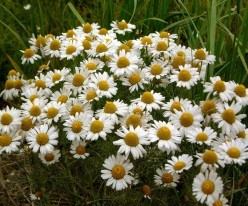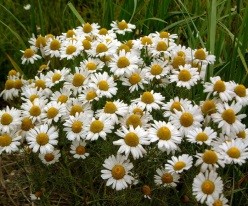Area
Medicinal chamomile is widespread, it grows mainly in meadows, arable lands (as a weed), roadside. It is mainly found in the south of the European part of Russia, the Caucasus, Crimea, Ukraine, the southern regions of Siberia and Central Asia.
Chamomile grows very quickly.
Botanical description of the plant
The medicinal chamomile belongs to the family Astradosh -Asteraceae.
Medicinal chamomile is an annual herb that reaches 15-40 cm in height. Stems erect, branched, hollow. The leaf is divided into two petioles, the segments are thinly linear, with a sharp tip. The stems and branches are completed with flowers gathered in a basket with a long band (short band of green chamomile). The flowers on the edge of the basket are white, talismanic, and in the middle are bisexual, yellow, tubular. Fruit - brown-green pistachio.
It blooms from May to autumn.

Medicinal properties
Chamomile has anti-inflammatory, anti-microbial, anti-allergic and anti-inflammatory properties, as well as wound healing. Therefore, its drugs are used in the treatment of gastrointestinal (in case of intestinal obstruction and diarrhea) and gynecological diseases, as well as as a sweat and hand drive. In addition, chamomile is used as a emollient, antiseptic and anti-inflammatory (in the mouth, throat, healing bath and enema).
The active part is a complex of chemical compounds (chamazulene, matrixin, apigenin, gerniarin, etc.) in chamomile. Hamazulen has sedative properties and has anti-intestinal, anti-allergic and anti-inflammatory effects. Apigenin, apiin, and gerniarin also have an effect against intestinal adhesions.
A tincture is made from chamomile flowers (baskets). Baskets are also used in gastric diseases, sore throats, and as part of emollients - teas.
Growing technology
Biological characteristics of seedlings: Although the germination of chamomile seeds begins at 6-7 ° C, the optimal temperature is 20-25 ° C. If the moisture is not enough after sowing the seeds, the seeds may not germinate for a long time. At this time the sown areas are irrigated. After germination (when humidity and air temperature are normal) in 20-40 days, each seedling will grow 6-10 rosette leaves. Seedlings planted in the fall overwinter in this case. From seedlings planted in early spring in the first ten days of April will grow 7–9 rosette leaves. During the March-April period, as a result of spring floods, rapid growth and enlargement of the rosette leaves leads to the growth and branching of the stem between the plants. If the plant is well supplied with moisture, the first flowers will open in the first ten days of May as a result of rising temperatures. In general, we see the first flowers open in 30-50 days from seeds sown in the spring. Observations have shown that flowers can open in 10-12 days from the buds that have just appeared on the plant stems. Undoubtedly, air temperature, soil moisture and nutrients in the soil play an important role in this. Depending on the heat of the day and soil moisture, a single basket on a plant can be left open for 5-6 days. A good opening of the flowers was observed when the air temperature averaged 19-21 ° C. An increase in temperature above 30 ° C adversely affects the opening of the flowers, leading to their crushing. Fertility is also important in the opening of flowers. The fact that the air is clear without clouds helps the flowers to open quickly. Methods of cultivation. Chamomile loves seeds, loves moisture, and it is advisable to grow it in fertile soils. Therefore, before sowing the seeds, the soil is plowed to a depth of 25-30 cm, adding 20-25 tons of local fertilizer (manure) and superphosphate per hectare. Minerals in the soil should be sufficient for plant growth and development. It is advisable to plant the chamomile plant for 2–3 years, and then plant another medicinal or agricultural plant instead. Otherwise, the yield may decrease from year to year. As chamomile is a spring-hardy plant, it is also possible to plant evening crops in the fields vacated by it in July and August and get additional harvest from them. It is desirable that the areas where chamomile is planted should be as fertile as possible, with no trees and fertile soil.
Cultivation to a depth of 4-6 cm, taking into account the increase in weeds during the growth of seedlings, leads to the disappearance of weeds. Rapid plowing, even after harvesting, helps to clear these areas of weeds and rot plant debris under the soil.





